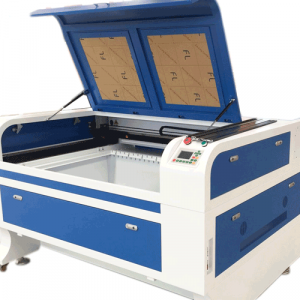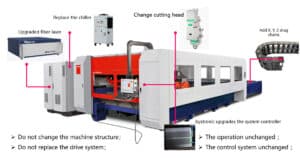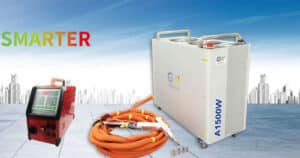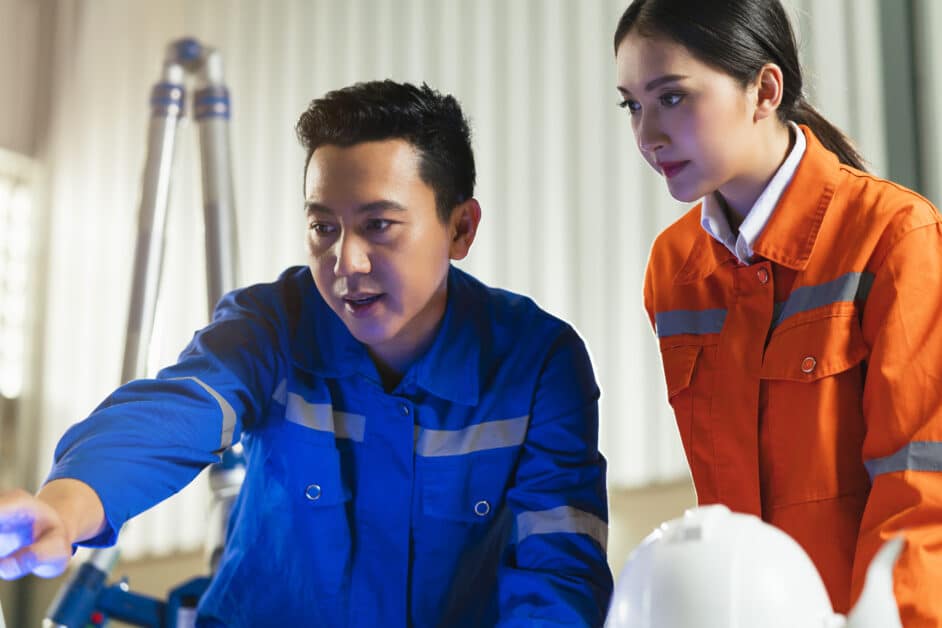Prolong CO2 Laser Tube Lifetime with a Laser Water Chiller
A laser water chiller is often used to cool CO2 laser glass tube, semiconductor laser, or fiber laser of laser equipment such as cutting machine, marking machine, engraving machine, and so on.
During the long-term operation of the laser equipment, the laser generator will continue to generate heat and cause the temperature to rise continuously, and the high temperature will affect the normal operation of the laser generator, so it is necessary for the laser water chiller to carry out water cycle cooling and temperature control.
A laser water chiller is a personalized application of industrial refrigerators in the laser industry. Water chiller mainly carries out water cycle cooling to the laser generator of laser equipment and controls the use temperature of laser generator. so that the laser generator can work normally for a long time.
The type of water chiller matched with laser is selected as far as possible, which can monitor water cooling temperature, pressure, flow rate, and other process values, and has interlock protection with laser.
6 Key Features of Industrial Laser Water Chiller
At present, there are more and more manufacturers producing water chillers, and there are many refrigeration equipments to be selected in the daily production of many industries, but the application range of water chillers is relatively wide, and it can control the temperature within a specific range. and the refrigeration effect is stable, suitable for all industries.
However, according to different industries, the requirements for industrial chillers are also different.
When choosing the models of water chillers from different water chiller manufacturers, we summarized the following six elements :
1. Refrigeration and single machine refrigeration capacity
The cooling capacity of the water chillers are directly related to the energy consumption and operation economic effect of the whole unit, which is worth paying attention to.
The first step to selecting the best chiller industrial brand is to determine the water cooling requirements for the laser. Make sure you buy a laser water chiller that comes with clear information about its cooling capabilities in the operating manual. Not to mention, cooling capacity determines the chiller size. The heat load is the amount of waste heat that a laser chiller removes from a laser engraving machine. Typically, this value is in BTU/hr or watts. The chiller you choose must be powerful enough for the laser engraving machine you are using. We recommend a 3000 chiller for a 50-100W machine or something ranging between 5000 and 5200 for above 100W.
Here are some suggestions for your reference:
CW-5000 water chiller for 100W laser glass tube.
CW-5200 water chiller 150W laser glass tube.
CW-5300 water chiller for 200W laser glass tube.
CW-6000 water chiller for 300W laser glass tube.
CW-6100 water chiller for 400W laser glass tube
CW-6200 water chiller for 600W laser glass tube
2. Temperature range
When choosing an industrial water chiller, we should first consider the requirements of the enterprise for the production temperature.
The production temperature is of great practical significance to the type selection and system composition of the water chiller.
For example, there is often a fundamental difference between water chillers used for air conditioning and those used for cryogenic engineering.
3. Environmental protection
When selecting industrial chillers, we must consider the problem of environmental protection in order to facilitate the requirements of production, scientific research, and life.
For example, attention should be paid to the following: noise occurs during the operation of water chillers, and the noise value increases or decreases with the size of water chillers; and some refrigerants are toxic, irritating, flammable, and explosive; some refrigerants will destroy the ozone layer in the atmosphere, to a certain extent, will bring disaster to human beings.
4. Energy consumption
Energy consumption refers to power consumption and steam consumption.
Especially when selecting large industrial chillers, the comprehensive utilization of energy should be taken into account, because large chillers are a kind of equipment that consumes a lot of energy, so for large cooling stations, the comprehensive utilization and balance of electricity, heat, and cold should be fully considered, and special attention should be paid to the full utilization of waste steam and waste heat in order to achieve the best economic effect.
5. Quality of cooling water
The quality of the water chiller has a great influence on the heat exchanger, which endangers the equipment by scaling and corrosion, which will not only affect the reduction of the cooling capacity of the industrial cold water mechanism but also lead to blockage and damage of the heat exchanger tube.
6. Vibration.
The vibration will occur when the water chiller is running, but the frequency and amplitude vary greatly due to different types of units.
If there is an anti-vibration requirement, the chiller with a small amplitude should be selected, or the foundation and pipeline of the chiller should be treated with vibration reduction.
CW5000 Installation
1. Open the package to check if the machine is intact and all the necessary accessories are completed.
2. Open the injection port to feed cooling water.
Observing the water level gauge and adding water slowly, be careful not to have the water overflowed! For the cooling
of carbon steel equipment, water should be added an appropriate amount of anti-corrosion agent. Working in cold
north area, it’s better to use noncorrosive antifreeze fluid.
3. According to system conditions, please connect the water inlet and outlet pipe well.
4. Plug-in power, turn on the power switch. (Do not start up without water in the water tank!)
4-1. The power switch is turned on, the circulation pump of the chiller starts working. The first time of operating may cause more
bubbles in the pipe leading to a flow alarming occasionally, but running for a few minutes later, it will go back to normal.
4-2. After the first boot, you must immediately check whether the water pipe leaks.
4-3. Power switched on, if the water temperature is below the set figure, it is normal that fans and other components of the
machine do not work. The temperature controller will automatically control the working conditions of the compressor,
magnetic valve, fans and other parts based on the set controlling parameters.
4-4. As it takes a longer time to start the compressor and other components, according to different conditions, the time is
ranges from seconds to minutes, so do not turn off the power and again on frequently.
5. Check the water level in the water tank.
The first startup of the new chiller empties the air in the water pipe, leading to a slight water level decline, but in order to keep
the water level in the green area, it’s allowed to add adequate water again. Please observe and record the current water level,
and inspect it again after the chiller running for a period of time, if the water level drops obviously, please re-inspect the
water pipeline leakage.
6. Adjust parameters of temperature controller.
CW-5000 series uses an intelligent thermostat. Normally users do not need to adjust it. If it is really necessary, please refer to
“Operating status and parameters adjustment.”
Maintenance In Winter
The global temperature goes down obviously in the past few weeks. If the ambient temperature is too low, it may result in water freeze inside of co2 glass laser tube & water chiller and broken them. So we have to take more precautions, the following 3 solutions for options:
1. To keep the water chiller working with no stop for 24 hours and make sure the water flows continuously.
2. Draining water away from the water chiller and glass laser tube after machine working every day
3. Adopts anti-freeze fluid as our recommended attention: Please adopt recommended anti-freeze fluid, otherwise may damage the laser tube.
If the above solution 1 or solution 2are can not be adopted, then anti-freeze fluid will be necessary. We recommend brand “CLARIANT”, and its 2 models are suitable for laser products
1) AntifrogenN
2) AntifrogenL
The adding ratio is 3:7 (3 for anti-freeze fluid, 7 for cooling water), it will not be frozen under temperature -20℃
But another brand of anti-freeze fluid such as SINOPEC: FD-1may cause laser tube damage such as unstable laser beam, abnormal noise, laser power decreasing more than 10watt, and lifetime reduction. In the coming future, we will do more testing on another brand of anti-freeze fluid to get more options for customers.
Clean the water chiller before adding anti-freeze fluid
1. Drain the water away from the water tank and then clean the limescale
2. Exchange the filter of the water chiller if necessary
3. When winter pass and the temperature up, the water with anti-freeze fluid has to be changed to purified water again.
If the laser machine will not be used for a long time, the water inside of the laser tube, water chiller, and water pipes should be drained out, especially for the glass laser tubes. If the buyer did not carry out our instructions, any broken laser tube caused by this will not be guaranteed.
What Temperature Should a Laser Engraver Water Chiller Be?
We always recommend using distilled water for laser tube cooling, ensuring it stays between 60–70°F (16–21°C). Consistent using optimal CO2 laser tube temperature is actually a key to consistent laser performance.
Also, keep in mind that your laser beam will perform slightly differently at various cooling temperatures. The engraving result can look different if you change your laser cooling temperature, even by a few degrees. It’s impossible to estimate the perfect CO2 laser cutting temperature, although the ideal range is the same for engraving, from 60–70°F (16–21°C). You might benefit from experimenting at different laser cooling temperatures within this range to optimize your laser cutting and laser engraving operations.
The laser beam is produced by running high-voltage electricity through the sealed glass tube, where it excites the carbon dioxide and other gases, producing a monochromatic infrared (invisible) beam of laser light. As some gases are consumed in this chemical reaction, excess heat can cause the electricity to accelerate gas consumption — producing a more intense laser beam.
This phenomenon explains why laser cooling extends the tube’s lifetime and shows how differences in CO2 laser tube temperature can affect laser power settings. With all other variables the same, the laser beam will be slightly more powerful at higher temperatures, meaning that consistent cooling temps help ensure constant and replicable engraving performance. Following this principle, you should monitor how your laser performs at various temperatures within the recommended range and use your laser water chiller consistently.







